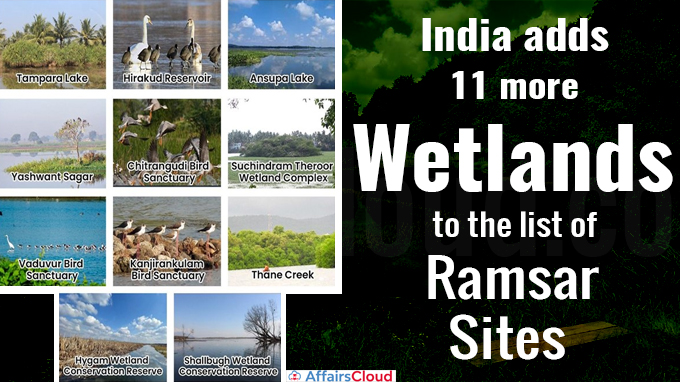
On August 13, 2022, India has designated 11 more wetlands under the Ramsar Convention or the Convention on Wetlands, taking the total number of Ramsar sites in India to 75 from 64 with area coverage of 13,26,677 hectare (ha).
- The 11 new sites include 4 sites in Tamil Nadu (TN), 3 in Odisha, 2 in Jammu & Kashmir (J&K), and 1 each in Madhya Pradesh (MP) and Maharashtra.
Points to be noted:
i.In 2022, a total of 28 sites have been declared as Ramsar sites. Based on the date of designation mentioned on Ramsar Certificate, the number is 19 for this year (2022) and 14 for previous year (2021).
ii.TN has maximum no. of Ramsar sites (14). It is followed by Uttar Pradesh (UP) which has 10 Ramsar sites.
iii.Between 1981 to 2013, 26 sites were designated as Ramsar Sites while the years of 2014-2022 saw the designation of 49 sites.
Following table showing the newly inducted wetlands as Ramsar sites:
| Name of wetland | Area in Ha | State |
|---|---|---|
| Tampara Lake | 300 | Odisha |
| Hirakud Reservoir | 65400 | |
| Ansupa Lake | 231 | |
| Yashwant Sagar | 822.90 | Madhya Pradesh |
| Chitrangudi Bird Sanctuary | 260.47 | Tamil Nadu |
| Suchindram Theroor Wetland Complex | 94.23 | |
| Vaduvur Bird Sanctuary | 112.64 | |
| Kanjirankulam Bird Sanctuary | 96.89 | |
| Thane Creek | 6521.08 | Maharashtra |
| Hygam Wetland Conservation Reserve | 801.82 | Jammu and Kashmir |
| Shallbugh Wetland Conservation Reserve | 1675 | |
| Total area of 11 sites | 76316 |
Brief of 11 new wetlands:
i.Tampara Lake (Odisha): It is located in the Ganjam district of Odisha. It supports at least 60 species of birds, 46 species of fishes, at least 48 species of phytoplanktons, and more than seven species of terrestrial plants and macrophytes. It is an important habitat for vulnerable species such as Cyprinus carpio, common pochard (Aythya ferina), and river tern (Sterna aurantia). With an estimated average fish yield of 12 tonnes per year, the wetland is an important source of livelihood for the local communities.
- The depression on the ground gradually filled with rainwater from catchment flow and was called Tamp by the British and subsequently termed Tampra by the locals.
ii.Hirakud Reservoir (Odisha): Initiated in 1957, it is the largest earthen dam in Odisha. Out of the known 54 species of fish from the reservoir, one has been classed as being endangered, six near threatened and 21 fish species of economic importance. The reservoir is a source of water for producing around 300 MW of hydropower and irrigating 436,000 ha of cultural command area.
- A fishery presently yields a catch of around 480 MT of fish annually and is the mainstay of livelihoods of 7,000 fisher households.
iii.Ansupa Lake (Odisha): Located in the in Banki sub-division of Cuttack district of Odisha, it is an oxbow lake formed by River Mahanadi and is spread over an area of 231 ha. It is home to at least 194 species of birds, 61 species of fishes and 26 species of mammals in addition to 244 species of macrophytes.
- It provides a safe habitat to at least three threatened bird species- Rynchops albicollis (EN), Sterna acuticauda (EN) and Sterna aurantia (VU) and three threatened fish species- Clarias magur (Clariidae) (EN), Cyprinus carpio (Cyprinidae) (VU) and Wallago attu (VU).
iv.Yashwant Sagar (MP): It is one of the two Important Bird Areas (IBA) in the Indore region as well as one of the most important birding sites in Malwa region of MP. It is mainly used for water supply to the city of Indore and is also being used for fish culture on a commercial scale.
- It is considered to be a stronghold of the vulnerable Sarus Crane in central India.
v.Chitrangudi Bird Sanctuary (TN): Locally known as Chitrangudi Kanmoli, it is located in Ramanathapuram district in TN. The wetland is a protected area since 1989 and declared as Bird Sanctuary. Around 50 birds belonging to 30 families have been reported from the site. Out of these 47 are water birds and 3 terrestrial birds.
- The wetland also supports a number of fishes, amphibians, molluscs, aquatic insects, and their larvae forming good food sources for arriving waterbirds.
vi.Suchindram Theroor Wetland Complex (TN): It is a part of the Suchindrum-Theroor Manakudi Conservation Reserve. It is declared an Important Bird Area and lies at the southern tip of the Central Asian flyway of migratory birds. It was formed for birds’ nesting purposes and it attracts thousands of birds every year. It is a man-made, inland Tank and is perennial. Copper plate inscriptions from the 9th century mention Pasumkulam, Venchikulam, Nedumarthukulam, Perumkulam, Elemchikulam and Konadunkulam.
- Around 250 species of birds have been recorded in the area, of which 53 are migratory, 12 endemic, and 4 threatened.
vii.Vaduvur Bird Sanctuary (TN): It is a large human-made irrigation tank and shelter for migratory birds. Indian Pond Heron Ardeola grayii occurred in most of the surveyed tanks. Large concentrations of wintering waterfowl such as Eurasian Wigeon Anas penelope, Northern Pintail Anas acuta, Garganey Anas querquedula were recorded in tanks.
viii.Kanjirankulam Bird Sanctuary (TN): It is a Protected area near Mudukulathur Ramanathapuram District of TN. The site qualifies as an IBA as the threatened Spot-billed Pelican Pelecanus philippensis breeds here. The wetland exhibits rich biodiversity including many globally near-threatened species like Spot-billed Pelican, Oriental Darter, Oriental white Ibis and Painted Stork and also commonly occurring shore and water birds like greenshank, plovers, stilts and forest birds like bee-eaters, bulbuls, cuckoos, starlings, barbets, etc.
- The wetland supports IUCN RedList vulnerable avian species like Sterna aurantia (River Tern).
ix.Thane Creek (Maharashtra): It has been declared as Thane Creek Flamingo Sanctuary. It is fringed by mangroves on both banks & comprises around 20% of the total Indian mangrove species. It has been categorized as IBA.
- Other than 202 avifaunal species, the creek also houses 18 species of fishes, crustaceans & molluscs, 59 species of butterflies, 67 species of Insects, and 35 species of phytoplankton, and 24 species of zooplankton & 23 species of Benthos.
x.Hygam Wetland Conservation Reserve (J&K): Located in the Baramulla district of J&K, it falls within the River Jhelum basin. It plays a significant role as a flood absorption basin, biodiversity conservation site, eco-tourism site, and livelihood security for the local communities.
xi.Shallbugh Wetland Conservation Reserve (J&K): It is located in the Srinagar J&K. It has has extensive reedbeds of Phragmites communis and Typha angustata, and rich growth of Nymphaea candida and N. stellata on open water. The wetland is important for the recharge of aquifers.
- It serves as an abode to more than four lakh resident and migratory birds of at least 21 species.
About Ramsar Sites:
Ramsar Sites or Ramsar recognition is the identification of wetlands around the world, which are of international importance under The Ramsar Convention on Wetlands. The convention is an international treaty which aims at the conservation and sustainable use of wetlands.
- Named after the city of Ramsar in Iran, the convention was signed in 1971.
- The Ramsar Convention works closely with six other organizations known as international organization partners (IOPs), namely BirdLife International, International Union for Conservation of Nature (IUCN), International Water Management Institute (IWMI), Wetlands International, WWF International, and Wildfowl & Wetlands Trust (WWT).
- To be a Ramsar site, at least one of the nine criteria as defined by the Ramsar Convention of 1971 must be met by the wetland.
- India signed the Ramsar Convention in February 1982.
Static Information:
i.Wetlands in UP and Gujarat serve as important spaces for migratory birds.
ii.Sundarbans in WB is the largest Ramsar site in India.
iii.Chilika lake is Asia’s largest brackish water lagoon and first Indian wetland of international importance under the Ramsar Convention.
iv.The United Kingdom (175) and Mexico (142) have the maximum Ramsar sites whereas Bolivia spans the largest area with 14,842,405 hectares under the Convention protection.




